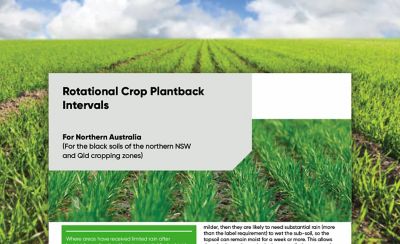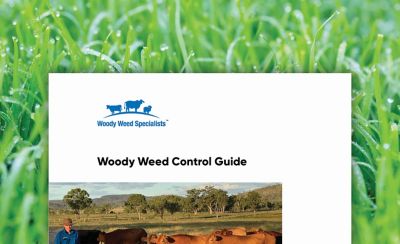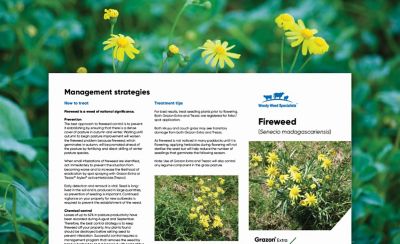Grazon® Extra
- Herbicide
group
- 4
Grazon Extra offers control of the broadest list of weeds in a single product, backed by a performance guarantee.
With three active ingredients, Grazon Extra sets the standard for foliar applications on hard-to-kill noxious and woody weeds, saving time and money with its outstanding knockdown and residual control.
Major Weeds Controlled
|
|
See Grazon Extra label for full list of weed species.
Technical Specifications
-
Active Ingredient300 g/L triclopyr; 100 g/L picloram, 8 g/L aminopyralid
-
Mode of ActionPlant cell growth disruption (all pyridines)
-
FormulationsEmulsifiable concentrate liquid
-
Group
4
-
Packaging
1 L, 5 L and 20 L
Features
Mode of action
Acts on both foliage and roots to provide rapid brownout of leaves, dry down of stems and destruction of the root mass to prevent regrowth. Leaf brownout and distortion of stem tips will normally be obvious within a week of application.
Residual activity
Selectivity
Application
Grazon Extra can be applied in:
Agricultural non-crop areas,
Commercial & Industrial areas,
Forests,
Pastures,
Rights of way,
Fallow
Equipment required for application
- Depending on the size of the job at hand:
- Large dense infestations (for example, large, old dense blackberry stands) are best treated with a large motorised pump and hand gun unit. This equipment can often be hired or a contract spray applicator can be engaged.
- However, a suitable knapsack or hand pump spray unit will suffice in many situations, provided that good coverage can be achieved (to the point of run-off).
- Ideally use a spray unit that is dedicated for application of herbicides only (to avoid cross contamination).
- Measuring jug.
- Cotton overalls or long-sleeved shirt and long pants.
- Washable hat.
- Elbow-length PVC gloves.
- Safety glasses or face shield.
Application Rate
For most weeds the application rate of Grazon Extra to apply is between 350 and 500 mL per 100 litres of water.
Always check the label for the correct rate.
Grazon Extra Mixing Instructions
If possible, mix Grazon Extra with clean water sourced from town supply or a rain water tank, although any source of clean water may be used. Avoid using water that is particularly ‘hard’ or strongly alkaline as that may reduce herbicide efficacy. Half fill the spray tank with water then add the Grazon Extra before adding the remainder of the water. If the product label requires the addition of a spray oil, penetrant or wetting agent to assist in control your particular weed population, mix in once the spray tank is full.
Once mixed, the spray solution should ideally be kept agitated and used immediately. However, if circumstances conspire to interrupt spraying, a mixture of Grazon Extra and water can be stored for up to seven days, provided that it is intermittently agitated each day, and well agitated again before use.
Application Timing for Best Results
In general, smaller weeds are easier to control than large ones.
Grazon Extra is most effective when applied to weeds that are not stressed due to lack of moisture, excessive heat, insect or pathogen (such as rust) damage, etc. and are actively growing. Actively growing weeds will draw the chemical into the vascular system and transport it through the stems and down to the roots to ensure maximum efficacy.
Grazon Extra needs to penetrate into the leaves of treated weeds before any rainfall occurs so do not make applications if rain is possible before the spray is completely dry – usually one hour. Similarly, avoid application if the leaves are wet from rainfall or dew.
Once the weeds have been sprayed leave them undisturbed so that the chemical is able to move throughout the leaves, stems and roots and provide complete kill. Disturbing the weeds by slashing, burning, mulching, etc. before the chemical is fully distributed will compromise the control achieved. We recommend that blackberries and other woody weeds not be disturbed for six months after spraying to maximise the performance of Grazon Extra.
Application Methods
Apply as a foliar spot spray to completely wet all leaves and stems. Coverage should be to the point of run-off in that the chemical mix is just beginning to drip from the leaves once the spraying is completed. Think of painting a wall and use that motion in your spray action to achieve full coverage of the foliage, then use a more directed stream to thoroughly treat the stems and canes.
This type of application is called high volume spraying as you are applying a large amount of spray mixture to the target weeds. Provided that good coverage of the target weed is possible, high volume spraying can be completed using a variety of equipment – from a small hand pump unit to a knapsack sprayer through to a large motorised pump and hand gun unit.
With a foliar spray you are looking to capture enough chemical on the foliage to kill not only the above-ground portion of the weed but all of the root mass as well, so good coverage is essential. If you are spraying very large weeds like blackberries that are several years old, ensure that canes on the inside as well as the outside of the foliage mass receive direct contact with the applied spray.
As a guide, one hectare of blackberries 1–2 metres in height will typically require a spray volume of 3000–4000 litres to be thoroughly covered, whilst the same area of a small herbaceous weed such as ragwort will require 500–1000 litres.
Stewardship
Grazing stock destined for local markets
There is no grazing withholding period (WHP) for stock feeding in pastures in which woody weeds such as blackberries have been sprayed with Grazon Extra, provided the stock are not destined for slaughter for export markets and stock can continue to graze while weeds are being treated.
However, care does need to be taken because some treated weeds often become very palatable to stock, as there is an increase in the plant’s sugar content as it dies, and stock will preferentially graze on these over the pasture grasses. If naturally toxic weeds such as ragwort, variegated thistle and capeweed are being sprayed, stock should be kept from the paddocks until these weeds have died.
Stock destined for export market
Stock destined for export markets should be prevented from feeding in paddocks sprayed with Grazon Extra for 42 days after application. Alternatively, stock can continue to graze treated pastures inside the 42-day period but must then be fed on clean feed (from outside the treated paddock) for at least three days before going to slaughter. (NB: The grazing WHP or ESI has nothing to do with market – but relates to slaughter.)
Spray Considerations
Many desirable crops and ornamentals are very sensitive to Grazon Extra so care must be taken when applying the product to ensure that there is no spray drift on to desirable plants or soil containing roots of desirable plants. A light but steady breeze directing any spray mist away from desirable plants is the ideal spraying condition. Avoid application when the wind direction is towards desirable plants or there is no breeze at all. In seemingly still conditions, spray mist can drift for long distances and in many directions, which can cause plant damage when it settles.
Plants susceptible to Grazon Extra include (but are not limited to) fruit trees, grape vines, legumes (pea, beans, lucerne etc.), vegetables, potatoes, roses, shade trees and tomatoes.
Residues
Residues of Grazon Extra can remain active in the soil for many months with the longevity affected by use rate, soil type, soil organic matter, temperature and moisture. Care therefore needs to be taken when planting new plants, crops or trees into areas where Grazon Extra has been sprayed to ensure that no residues remain active. Details of how to conduct a suitable soil bioassay to check for residue levels can be found on the Grazon Extra label.
Residues of Grazon Extra can also remain in treated plant material for extended periods so do not use treated plant material to make compost or mulches. Any manure from animals grazing on treated pastures within six months of application of Grazon Extra should not be sold off-farm or used as compost within gardens.
Grazon Extra may be used around waterways but spray should never be applied to water, or soil within a dry water course, or allowed to drift into or drip off treated foliage into water.
Cleaning spray equipment
After spraying is complete, thoroughly clean the spray unit to ensure no residues remain that may cause damage to desirable plants when the equipment is next used. Empty the spray unit completely and drain the whole system. Wash the tank, pump, lines, hoses and nozzles with a mix of water and an alkaline laundry detergent such as Omo® or Drive®. Reassemble the unit, half fill with clean water and circulate through the pump and hose. Drain and repeat the rinsing procedure.
Ensure rinse water is disposed onto a designated area or an unused area where there is no risk to desirable plants.
Additional Resources


Rotational Crop Plantback Intervals
Northern Australia – for the black soils of the Northern NSW and Qld cropping zones.
View now
Woody Weed Control Guide
The Woody Weed Control Guide is the essential handbook for controlling woody weeds on your property. It contains everything you need to know about what herbicide to use on what weed and is updated each year with the latest weed control knowledge to ensure that you can stay up to date with the most effective ways to manage weeds on your property.
View now
